#Egyptian mummified remains
Explore tagged Tumblr posts
Text
Author & Timestamp: Sarah Kuta for Smithsonian Magazine, April 30, 2024.
Note: this is an emotive topic and it is not one I feel qualified to give an opinion on yet. My sharing of this extract and link neither supports nor argues against any particular viewpoint, it's simply to take note of a conversation that I feel is important.
Extract:
[T]he Chau Chak Wing Museum at the University of Sydney [has] removed fragments of mummified bodies from public display. Museum staffers also plan to rename the “Mummy Room” to more accurately and respectfully reflect mummification’s significance in ancient Egyptian culture.
[...]
Egyptologist Melanie Pitkin, [...] a senior curator of antiquities and archaeology [at Chau Chak Wing], is leading the charge to rethink how the museum displays and interprets its Egyptian collection.
[...]
“For hundreds of years, body parts in museum collections have been treated as objects,” says Pitkin in a statement. “We have become so accustomed to seeing them on show that we often forget they once belonged to living people.”
For now, the remains are being kept in the museum’s “closely monitored collection store” while curators work to “implement better practices with Egyptian communities and authorities,” according to the statement. In the display, the museum replaced the unwrapped body parts with ancient Egyptian funerary portraits from coffin lids and masks. Curators are also exhibiting a painted portrait from the Roman era.
[Two] completely wrapped, mummified bodies [...] along with 3D visualizations based on CT scans of the remains. The CT scan data of another mummified body [...] also remains on view.
[...]
“In renaming the room, we’d like to focus more on the transformation of the body into an eternal being [...], rather than the body itself,” Pitkin says [...]. “We also encourage visitors to critically reflect on the ethical complexities museums face when caring for human remains.”
[...]
“[Modern] cultural stereotyping [of ancient Egyptian mummified bodies] would elsewhere be recognized as a form of racism, but the ancient Egyptians are not here to object to the ways in which we depict them,” Jasmine Day, an Egyptologist [...], tells the Sydney Morning Herald.
[...]
Around the world, curators and policymakers are also reconsidering their approaches to other types of artifacts. Earlier this year, [...] Harvard University removed a book binding made of human skin from its library, while the Field Museum in Chicago covered some of its Native American artifacts.
/end of extract
#important discussions#academic debate#museum politics#curation#mummified human remains#human remains#history#ancient#archaeology#museum news#Chau Chak Wing Museum#University of Sydney#Australia#mummified bodies#ancient Egyptian#museum displays#ancient Egyptian artifacts#museum collections#egyptology#antiquities#curators#academic ethics#ethics#mummification#Egyptian mummified remains#ethical considerations#ancient Egypt#cultural stereotyping#smithsonian#academic discourse
1 note
·
View note
Text
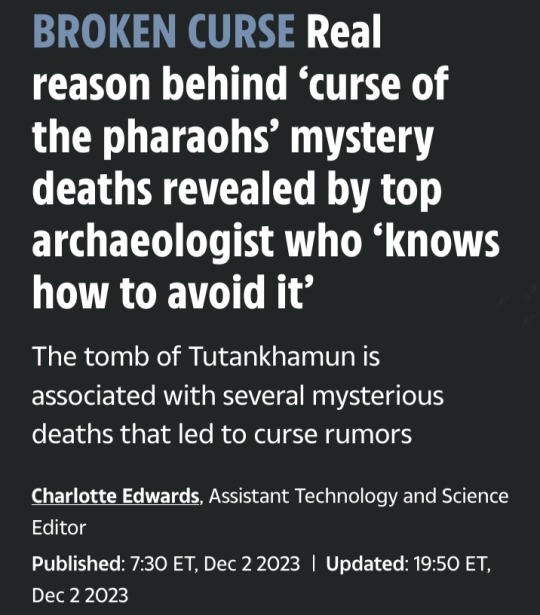
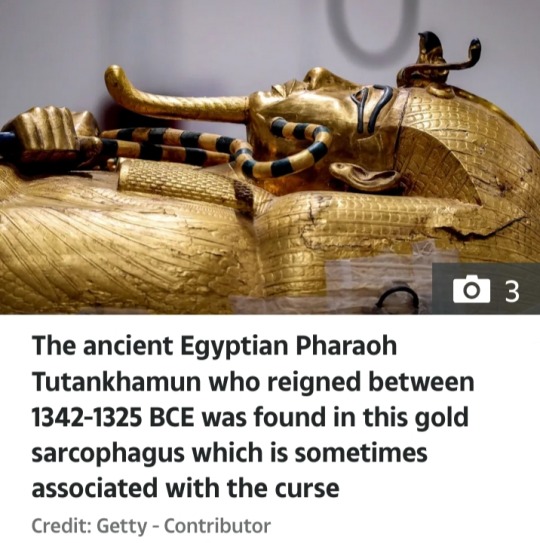
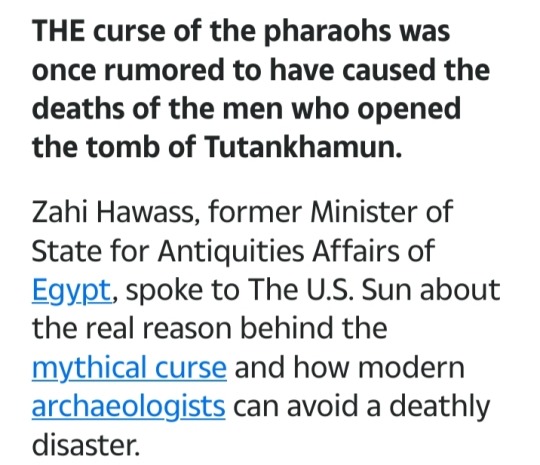
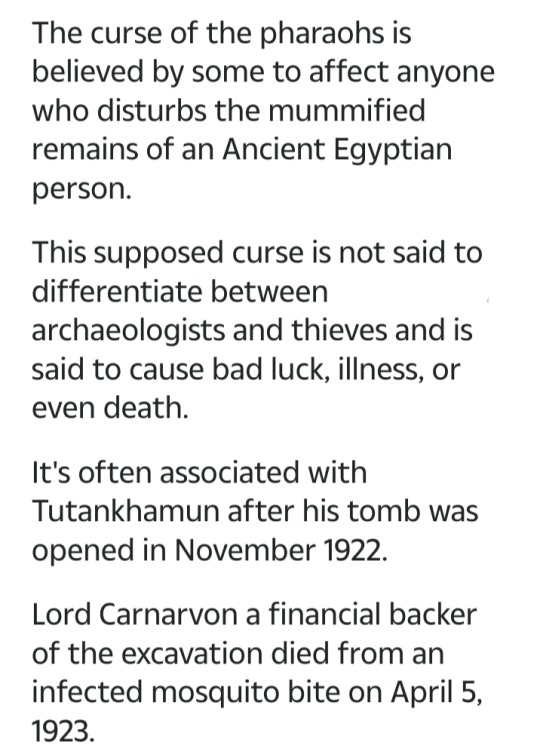
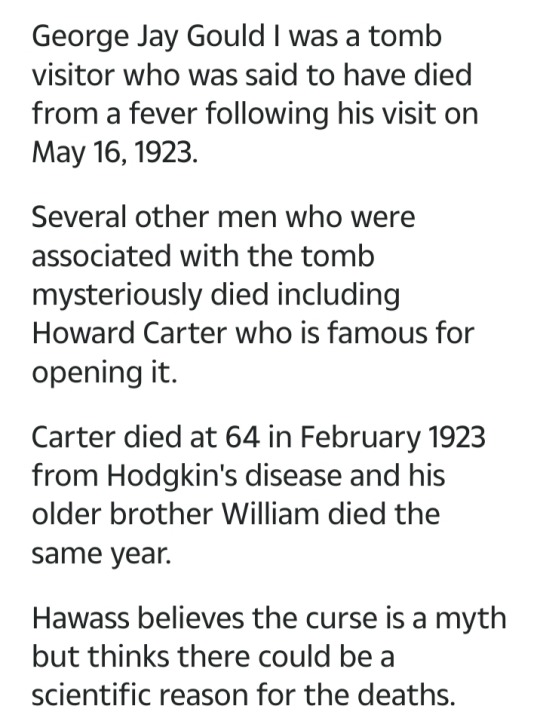
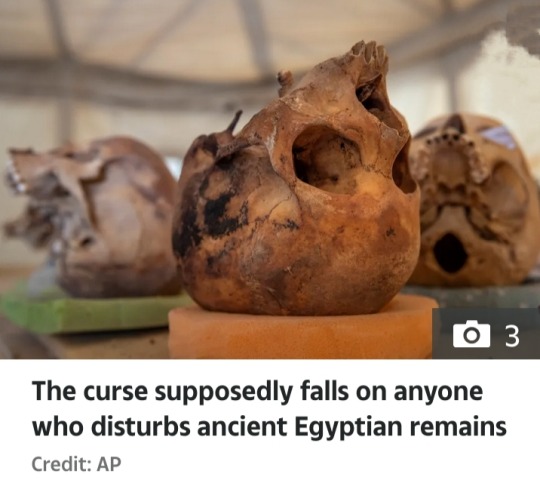
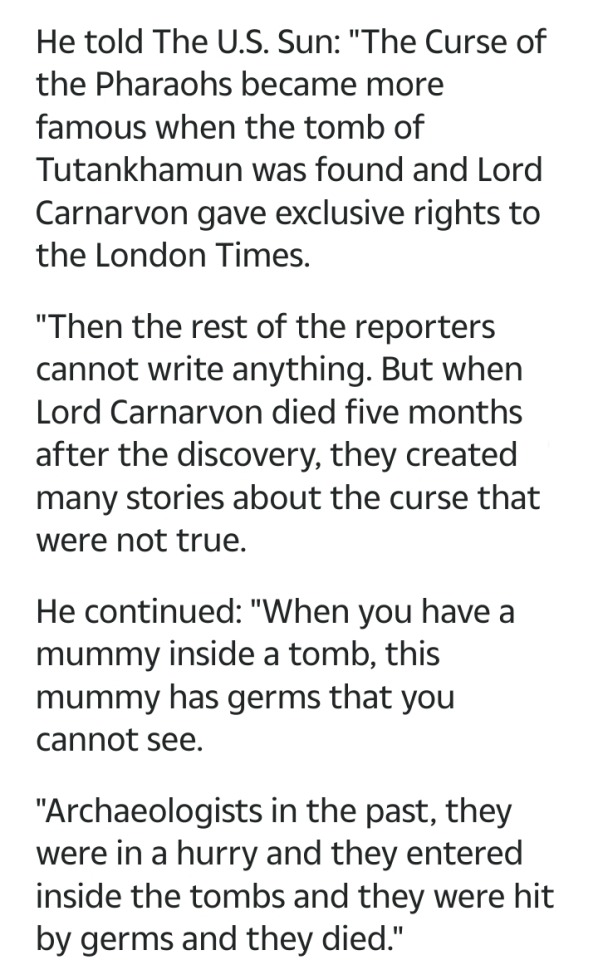
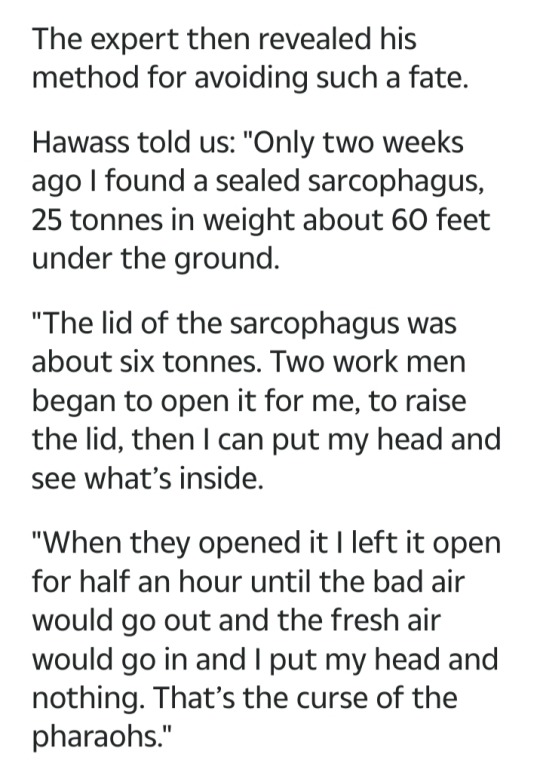

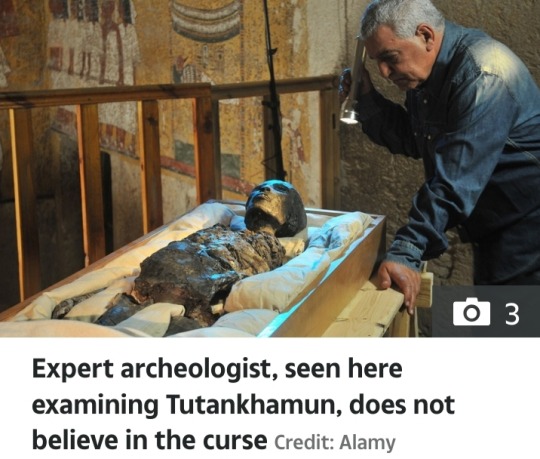
#Tutankhamun#Tomb of Tutankhamun#curse of the pharaohs#Ancient Egypt#Ancient Civilization#Dr Zahi Hawass#Minister of State for Antiquities Affairs#Egypt#mythical curse#archaeology#sarcophagus#mummified remains#Lord Carnarvon#Howard Carter#George Jay Gould I#mummies#germs#curse#Ancient Egyptian Pharaoh
62 notes
·
View notes
Text
Kalashire’s name means "giant, warrior", so fittingly he is a 5'10 solider
#Cipher talk#The joke is Egyptian men in the modern day are averaging 5'7 and probably were shorter in the past#There's a study of mummified Egyptian remains that puts the male average at 5'6 which like#Fits but it only used 150 examples total so I don't think it's a sufficient dataset#Sycamores before the flood#OFC there are taller Egyptian men I'm mostly poking fun at statistics
1 note
·
View note
Text
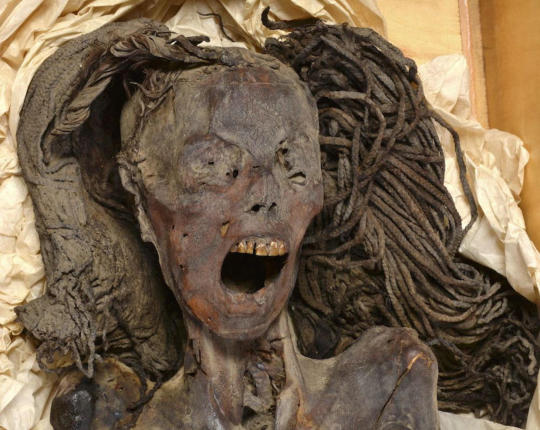
The "screaming mummy" refers to an ancient Egyptian woman whose mummified remains were discovered in 1935 during an archaeological expedition in Deir el-Bahari near Luxor, Egypt. This unknown woman was estimated to have lived around 3,000 years ago. She is notable for her facial expression, which appears to show a mouth open in a scream or cry.
Recent studies suggest that her contorted facial expression might indicate she died in extreme agony, possibly due to a painful execution or severe illness.
182 notes
·
View notes
Text
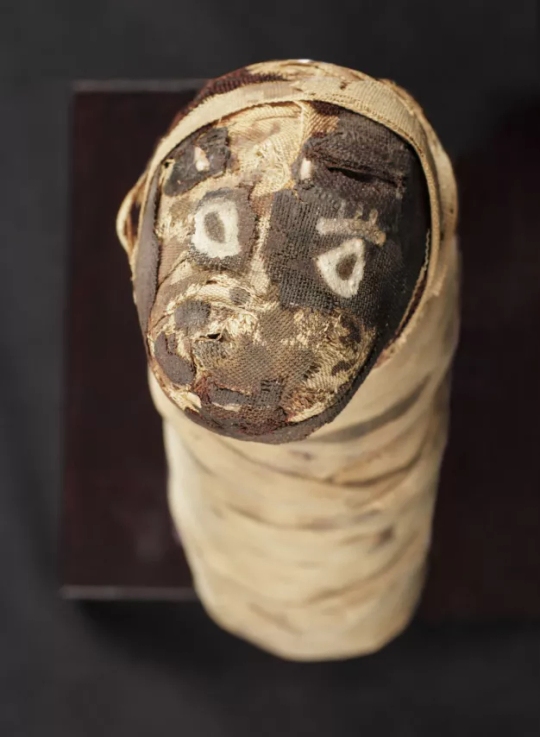
~ Mummified Dog.
Culture: Egyptian
Period: Roman Period
Date: ca. 30 B.C.–A.D. 395
Medium: Linen, pigment, and organic remains.
#ancient#ancient art#history#museum#archeology#ancient egypt#ancient history#archaeology#egyptology#Egyptian#egypt#mummy#mummified#mummified dog#Roman#roman period#dog#ca. 30 b.c.#ca. A.D. 395
801 notes
·
View notes
Text
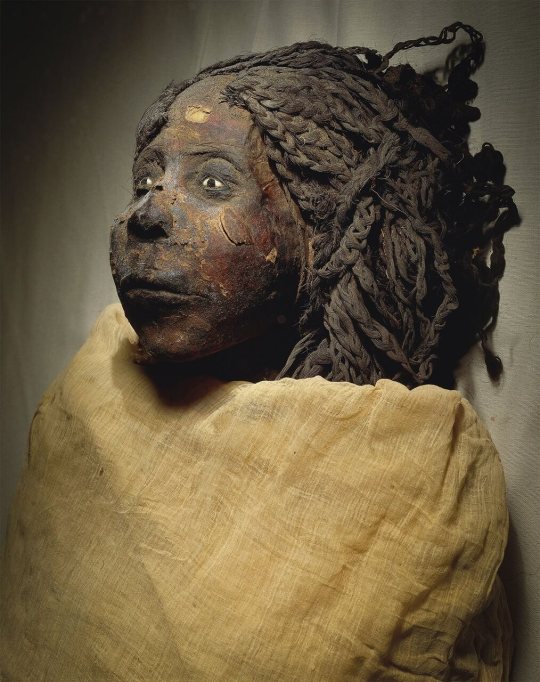
The mummified remains of Queen Nodjmet
Third Intermediate Period, 21st Dynasty, ca. 1069-945 BC. Now in the Egyptian Museum, Cairo. JE 26215
The mummy of Queen Nodjmet was found in the Deir el-Bahari Royal Cachette (DB320). The mummy had been given artificial eyes, made of white and black stones. The eyebrows are real hair and she wears a wig. Her body and parts of her face were colored to give her a more lively appearance.
Nodjmet was an ancient Egyptian noble lady of the late 20th Dynasty or early 21st Dynasty of Egypt, the wife of Herihor, High Priest of Amun at Thebes. She may have been a daughter of Ramesses XI. Early in her life, she held titles such as Lady of the House and Chief of the Harem of Amun.
Read more
325 notes
·
View notes
Note
Spaniards ate mummies in the Canary Islands?! WTF?
Mummia, a substance created from ground mummies was a popular medicine and aphrodisiac in medieval Europe and when it fell out of practice as a medicine, it was still used as a pigment in oil painting until the 1800s. Typically made from Egyptian mummies, Egypt banned the export of the substance in the 16th century.
The Spanish colonized the Canary Islands in the early 15th century and began making mummia out of the mummified remains of the Guanche people, who had inhabited the islands for upwards of 2,500 years at the time of Spanish arrival. The destruction was so total that less than 20 Guanche mummies remain in the whole of the Canary Islands. We cannot say for certain that the thousands of missing mummies were used for mummia, the Spanish may have simply desecrated and destroyed them.
67 notes
·
View notes
Text
Mythology Fact #1 - Sobek, Egyptian Crocodile God
NEW SERIES! Mythology Facts will explore many elements of world mythologies, but with a particular focus on Greek, Egyptian, and Norse, especially at the start.
Easily the winner of the first poll about this new series as held on my Patreon is Sobek, the ancient Egyptian crocodile-headed god!
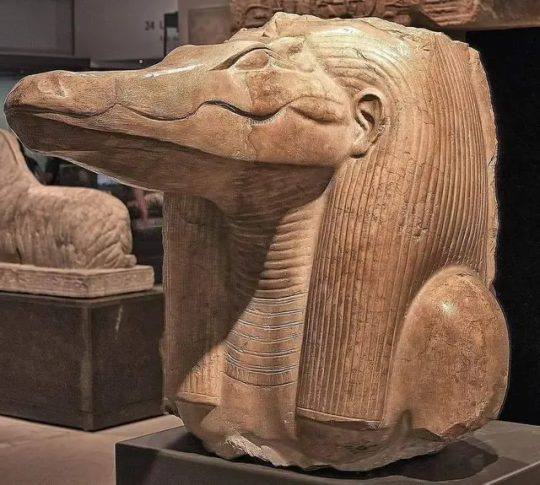
Head of a limestone statue of Sobek, as previously on display at the Met as part of a special collection; Met info on the statue head here
In ancient Egypt, like many ancient cultures, the most fearsome of beasts were highly regarded for their awe-inspiring endurance, power, and ferocity - a concept often little-understood today, as animals are now often seen as obstacles to be conquered or put out of the way, hence why it can occasionally be difficult to detail to the modern mind the relationship between men and wolves throughout history (but I'm not on that right now, so I'll stop). The people of ancient Egypt held great reverence for many animals, not least among them being the obviously very dangerous crocodile.
An integral part of life in ancient Egypt was the rise and fall of the Nile. Sobek was a centerpiece of the Nile life - crocodiles were abundant, a testament to their fertility and virility, and they were fearsome, strong, and enduring. Sobek's nature is intensely complex and his "domains," as we so often think of deities as having, were extensive, including but not limited to fertility, virility, illness, health, strength, pharonic power, military might, protection (especially protection from, essentially, bad luck), and the dangers and wonders of the Nile. By nature, he was considered animalistic, unpredictable, strong, protective but dangerous, and highly sexual, aspects frequently associated with the most powerful predators in a given region (notice all those things are also associated with wolves). Sobek was depicted variably as a crocodile and a crocodile-headed man, and holy crocodiles were kept in his name.
Given his association with the Nile and so many other things, Sobek was and mostly remained a very important figure, especially with his later fusion with/association with both Horus and Ra, two extremely important deities...
This is quite the lengthy post! More under the cut.
Among many other things, Sobek was said to have power of the fertility of the Nile's soil, as well as its waters, and thus also had great power over disease, as the Nile could also cause illnesses. Like so many ancient Egyptian deities, Sobek also had an association with the dead, being called upon to bring them sight and return their senses in the afterlife, as well as to assist in protecting them (along with many other deities, including but certainly not limited to Isis, Nephthys, and Anubis).
Sobek's strong association with fertility is found in his many epithets and even the name we use for him most - "Sobek" is thought to perhaps even come from a causative of "to impregnate" (though some scholars contend it instead means "to unite," especially in relation to the pieces of Osiris). Perhaps the first instance we have of Sobek in a text comes from the Pyramid Texts, in which a spell refers to Unis (the pharaoh) as a living incarnation of Sobek - the pharaohs were very often living incarnations of assorted deities at various times - and says that Unis "will copulate" very specifically and that he is the lord of something that would probably get this post censored, "who takes women from their husbands to the place Unis likes according to his heart's fancy."

Mummified crocodiles found in the Temple of Kom Ombo; we have found mummified crocodiles of all ages, even including fertilized eggs
Now let's talk about a thing called the petsuchos. Mummified crocodiles served as images of Sobek in various forms, one of which being Petsuchos, meaning "son of Sobek." It is thought one crocodile in particular took on the aspect of the petsuchos and was kept in Shedet, replaced by a new petsuchos whenever the previous died. Following the death of a holy crocodile, a great ritual took place to mummify the creature and then put it on display, as it remained ever sacred. Living crocodiles were sometimes kept in other temples and holy places, even including outdoor pools. They were adorned with gems and fed delicacies; some were even considered attractions, as feeding the holy crocodile brought good luck, given Sobek's apotropaic nature. There was even a divine crocodile breeding center established by Amenhotep III (who pushed the Sobek cult quite energetically).

There are many depictions of Sobek found throughout what we have of ancient Egypt, including many of its time periods. He is perhaps one of the oldest gods of ancient Egypt, having appeared as early as during the reign of King Narmer in the first dynasty. His importance during the Old Kingdom, as well, can be found in the Pyramid Texts. The entire region of Fayum was a cult center of Sobek, so great was his importance, the seat of which was - of course - the capital, Crocodilopolis or Shedet.
Also very worthy of note is Sobek-Ra, a combination of the gods Sobek and Ra, that appeared in very late-age Egypt in the New Kingdom (1150-1069 BC), and even continued into the Ptolemaic Period (around 332 BC to 390 AD). Sobek-Ra (or Sobek-Re if you want to go that way) may have first appeared during the reign of the first king of the Middle Kingdom, Montuhotep II, as addressed in the Coffin Texts used during the Middle Kingdom (in which Sobek is addressed as "he who rises in the east and sets in the west"). As a combination, depictions thereof often had the head of a falcon but the body of a crocodile, often wearing the solar disc and uraeus (cobra).
He combined aspects of both deities, which is also perhaps thanks to Sobek's association also with Horus. When Horus took on the aspect of a crocodile during his retrieval of Osiris's bodyparts, Sobek became associated with him, even considered an aspect of Horus. Likewise, however, Sobek also was said to have assisted Isis during Horus's birth. Such deity fusions, aspects, and deities becoming an aspect and/or appearing in various myths in nebulous forms were not uncommon in ancient Egypt, and Sobek was also combined with Horus at assorted other points. All of this continues to point to the association between Sobek and kings (pharaohs), especially when you reach the point of learning about Sobek of Shedet-Ra-Horus, but I won't go into all that here due to time constraints.
So, obviously, there's so much more to say that it's, frankly, crazy and almost overwhelming. The study of ancient Egypt is a complex undertaking, hence why we have an entire field called Egyptology. So, consider this very much a simplified overview. Hope you enjoyed the post!
And stay tuned for news and updates on a major [werewolf/fantasy/adventure/horror/epic] book release later this year! Likewise, if you enjoy mythology in general and Egyptian myth, be sure to check out my other works of fiction, including this one here--also available on Amazon.com and many other retailers. Sequel coming next year.
If you like my blog, be sure to follow me here and elsewhere for much more folklore and fiction, including books, especially on werewolves! You can also sign up for my free newsletter for monthly werewolf/vampire/folklore facts, a free story, book previews, and my other sundry projects and works.
Free Newsletter - maverickwerewolf.com (personal site + book shop) — Patreon — Wulfgard — Werewolf Fact Masterlist — Folklore Fact Masterlist — Mythology Fact Masterlist — X — Vampire Fact Masterlist — Amazon Author page
#mythology#myth#egyptian myth#egyptian mythology#ancient egypt#egypt#crocodile#crocodiles#the nile#nile#sobek#folklore#legend#egyptian deities#egyptian gods#mythology fact#history#egyptian history#research#fiction#Wulfgard#long post
60 notes
·
View notes
Text
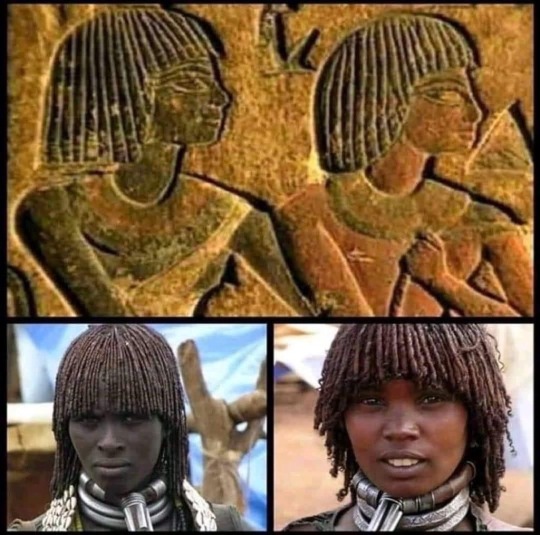
Some of the earliest depictions of dreadlocks or Sacredlocks date back as far as 1600–1500 BCE. In ancient Egypt, examples of Egyptians wearing locked hairstyles and wigs have appeared on bas-reliefs, statuary and other artifacts. Mummified remains of Egyptians with locked wigs have also been recovered from archaeological sites. This culture is still carried on today in Africa.
45 notes
·
View notes
Text
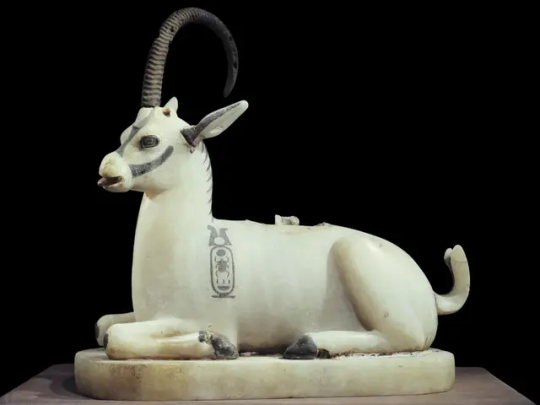
[ A jar in the shape of an ibex, retaining one natural horn, found in the tomb of the pharaoh Tutankhamun. Photographed by Robert Harding. ]
"Millennia ago, northern Africa was much wetter and cooler. Monsoons struck periodically, and the Sahara was covered with lakes and vegetation. This greener version of Egypt was home to a mix of wildlife more like the one now found in East Africa, with 37 species of large mammals including lions, wildebeest, warthogs and spotted hyenas. The region began to dry out about 5,000 years ago, a time that coincides with the fall of the Uruk Kingdom in Mesopotamia (located in present-day Iraq) and the rise of the pharaohs in Egypt. The Egyptian people at this time switched from a mobile, pastoral life to one of agriculture and subsistence hunting. The new research shows that several species of antelope, along with giraffes and rhinoceroses, disappeared around the same time—extinctions that could be due to overhunting of herbivores. Shortly afterward, the long-maned lion vanished. Egypt became even drier around 4,200 years ago, during a time known as the “First Intermediate Period” or the “dark period.” The region depended on yearly flooding of the Nile to inundate the land and leave behind nutrient-laden silt to feed agricultural fields. But during the dark period, this flooding became inconsistent, crop yields dropped and famine ensued. War and chaos reigned, and eventually the Old Kingdom—and with it, the “Age of the Pyramids”—ended. This is when the roan antelope and African wild dog disappeared from the records. A third aridification event occurred about 3,000 years ago, again bringing drought and an end to the New Kingdom, a time that included Tutankhamun and 12 kings named Ramses. Egypt’s short-maned lions, revered as sacred and even occasionally mummified, vanished around this time. Then about 150 years ago, as Egypt’s growing population became more industrialized, more species disappeared, including leopards and wild boar. Today, only 8 of the original 37 large-bodied mammals remain."
- Excerpt from "Egypt’s Mammal Extinctions Tracked Through 6,000 Years of Art" by Sarah Zielinski.
119 notes
·
View notes
Text
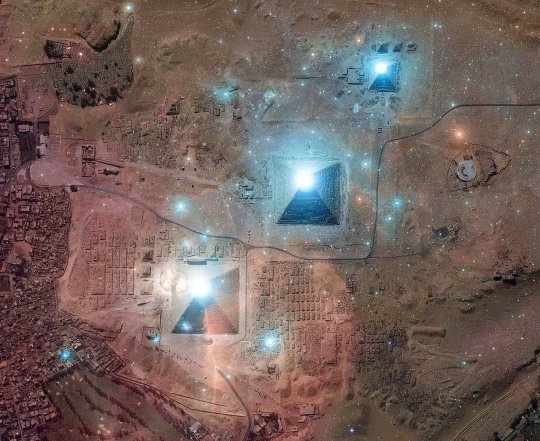
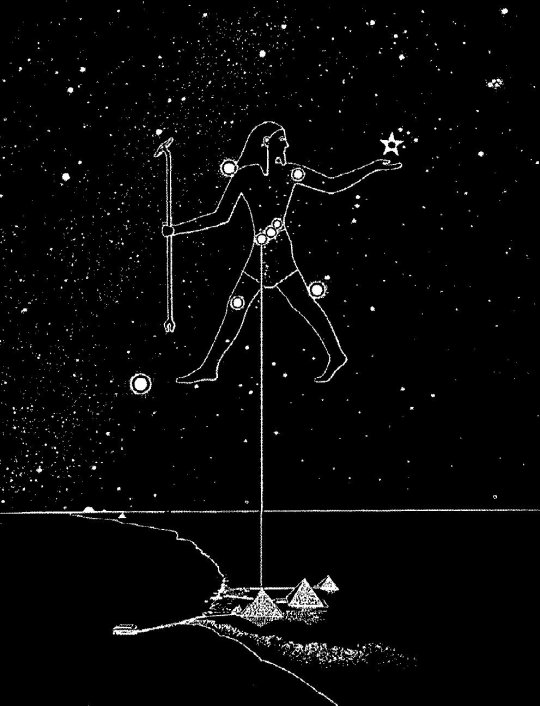
Orion's belt aligned with the Giza pyramids. Al Nitak points to the Great Pyramid. The gods left many signs using mathematics and astronomy, especially those signs built into the Great Pyramid.
Lions Gate Portal 8/8
August 8th, known as the Lions Gate, has been revered for several thousand years as the date that marks the peak of an influx of high-frequency energy onto planet Earth from the star Sirius, which is in its closest proximity to earth from July 26th through August 12th – the full period of the Lions Gate opening or Galactic New Year. Second in brightness only to the sun, to Ancient Egyptians this star was revered as their “Spiritual Sun” and referred to as Auset’s star Sopdet – Spdt, meaning “she who is sharp.”
The Lions Gate is the annual season when Spdt comes into her most pristine alignment with Re [the Sun], Geb [the Earth], and Sah – the Hunter constellation identified with ancient Egypt’s King Ausar – called Orion in Greek. During this cosmic portal, Sopdet – the spiritual Sun – emits an ancient activating energy so powerful as to cause the annual inundation which has sustained Nile River Valley communities over several millennia, whilst spurring the collective ascension of human consciousness throughout earth – the land or house of Geb/Keb. As God Djehuti proclaimed, “If the truth must be told, this land is indeed THE TEMPLE OF THE WORLD…” The August 8th peak of the Lions Gate is when Sopdet is said to perfectly align with the shaft from Queen Auset’s Chamber within the Great Pyramid of Giza, in concert with that from King Ausar’s Chamber aligning with Alnitak, one of the three stars of the Hunter constellation’s belt. Known as the “3 Wise Men” or the “3 Sisters,” these three stars form the cosmic blueprint from which the complex known as the Pyramids of Giza was built.
“As above, so below… As within, so without” are codes which remain key to Kemet’s ancient Mystery System. Thus, the Nile River represents the Milky Way (called Maziwa Mkuu in Kiswahili, meaning ‘great milk’) on earth ‘below’ as in heaven ‘above’. Two lions are said to hold open this magnificent time-space portal, one of which is represented by the Great Sphinx whose figure is an earthly representation of the constellation of Leo and a key piece of the puzzle of relationships within the Milky Way galaxy ‘above & below’. Lying on the west bank of the Nile river, the Great Sphinx is poised with its tail to the west [where the sun exits] as it faces directly east towards the sun’s reentry. The Lions Gate [7/26 – 8/12] opens within the astrological season of Leo, adding to the influx of regal energy from the alignment between Earth and the Universe’s Galactic Center, which reaches its peak on 8/8 over African soil. It is a powerful reminder of Heaven-on-Earth’s potency, symbolized ‘within & without’ through the quintessential Divine Love that exists between cosmic Hunter Ausar and his earthly Gatherer, Throne Queen, and Spiritual Sun – Auset.
According to the mythology of Ausar-Auset, in a jealous bid to usurp their Heaven-on-Earth throne, Set murders King Ausar, dismembering his body into 14 parts and scattering them in the wilderness [African Diaspora] so as to prevent his resurrection and return. Set the antagonist is god of chaos, foreign oppressors, violence, perversion, illness, and the desert who caused Egypt to be widowed of the gods and humanity to be trapped in his false predatory & parasitic matrix. After widow Auset searches the wilderness and manages to retrieve and mummify only 13 of her husband’s mutilated body parts, it is up to Heru, her posthumously/immaculately-conceived son with King Ausar, to become the Warrior who avenges his father’s fate and restores divine order to the kingdom by defeating Set…
Pyramid texts speak of Heru as the Great Lion: “Horus who comes forth from the acacia to whom it was commanded: ‘Beware of the lion’. May he come forth to whom it was commanded: ‘Beware of the lion’.” [Pyramid Text 436a-b]
Africa’s Acacia tree, which is sacred to goddess Auset, has long been associated with ancient mysteries including the secrets to life, death, healing, sustenance, and resurrection – hence their organic ties to matriarchal goddesses. Linked to the Akashic Records, the astral ancestral library where everything that has or will ever occur is recorded, the Acacia trees in Heliopolis were thought to have been the birthplace of the very first deities. Heliopolis (called On in Lower Egypt), was the ancient worship center of sun-god Re whose celestial boat was made of Acacia wood in its hind parts (palm wood in its fore-parts). The mythologies of Ausar-Auset are Heliopolitan in their derivation and orientation, e.g. the reference to Ausar as ‘the one in the tree… the solitary one in the acacia.’ This saying was based on the version of their story in which Auset releases her husband’s body from a pillar in Byblos [a prophecy relating to the scripted bible?] that had been fashioned out of the tree which enclosed the coffin King Ausar had been tricked into entering as Set’s ploy to usurp/colonize Egypt’s throne. Symbolizing the immortality of the soul in Freemasonry, the thorny acacia tree otherwise represents Ausar’s backbone, depicted as the Djed Pillar in this particular mythological account.
Trees act as resurrection portals and/or gateways between worlds in ancient Egyptian Mysteries, such as the Sycamores (associated with goddesses Nut & Hathor) through which Re rises as the Sun each day from the east: “I know the two sycamores of turquoise between which Re comes forth, when he passes over the supports of Shu to the gate of the lord of the east from which Re comes forth” [Book of the Dead: Ch. 109]. Auset & Nepthys were regarded similarly as “the two Acacias.” Thus, these Mother Trees act as do the two lions which hold open the portal for the “Spiritual Sun” Sopdet to rise as the consort of Sah during the Lions Gate season, in order to usher forth the blessings of the Galactic New Year with the annual inundation of the Nile River. Their child, hawk god Heru-Sopdu is referred to as “Lord of the East,” thus presaging mythologies surrounding the Ausar-Auset-Heru trinity as archetypal personifications of key spiritual motifs that connect us organically to our higher selves… “As above, so below.”
“As within, so without” is a principle that plays out in the eternal relationship that exists between Ausar-Auset, their love representing a Heaven-on-Earth divine order, which is interrupted by the chaos that Set’s predatory & parasitic rule brings, i.e. until Heru is able to successfully accomplish his Hero’s Journey and restore Ma’at/UbuNtu… unity-consciousness. For Africa, the earthly source and staging of these love-as-salvation narratives, Set is representative of a false matrix built on slavery, (neo)colonialism, apartheid, misogyny, misogynoir, etc. – controlling foreign narratives which have in-formed external elite-run global systems & misled most of humanity into profound states of isolation, alienation, disconnection, and disorientation from organic & natal bonds. Heru – “[the Lion] who comes forth from the acacia…” [Pyramid Text 436a-b] – thus has his work cut out for him.
Again, in this case the acacia reference represents a fascinating organic matriarchal portal between worlds for Heru as a human prototype resident in each of those who do not entertain predatory or parasitic relationships of dysfunctional dependency [read “slavery… apartheid… (neo)colonialism… misogyny… misogynoir…”], but strategically translated into self-referential Europatriarchal scripture as mankind’s singular “savior” [Jesus]. Deep inside Africa – the regal lion‘s natal home – the acacia tree itself has a characteristic dome-shaped canopy due to the way indigenous giraffes graze, which they have to do carefully because the acacia senses this feeding activity and releases tannin, a defensive poison that can kill from the overgrazing of its leaves. The acacia then emits ethylene on the wind, a chemical that alerts other acacia trees to preemptively defend themselves against “predators” by producing tannin also. DMT, a hallucinogen associated with spiritual experiences, is present in various species of the tree such as the Acacia Nilotica.
The Lions Gate represents so much to so many, especially during this dramatic period of humanity’s ascension in 2020 (Gregorian timeline). Feline power, highly revered in Kemet, is front and center as the astrological symbol for Leo and also as the identity of the African goddess annointed as “Opener of Heaven’s Door.” Among her other titles, Goddess Seshat – “Foremost of the per-Ankh” – is also known as the “Panther Goddess” and “She of Seven Points” in reference to her highly emblematic dress and crown, respectively. Appropriated by Europatriarchs in their design of Lady Liberty following America’s post-Civil War end of slavery, Seshat‘s 7-pointed crown has symbolically countered the racist & misogynistic tendencies of false 3D matrix systems. Seshat‘s traditional panther-skin dress returns our consciousness to humanity’s African source and the need to descramble & purge predatory Victorian-era matrix codes which, during the receding Piscean era, morphed into parasitic neo-colonial arrangements, hijacking the human spirit and its potential. These & other ancient unity-conscious codes [UbuNtu] are key to human ascension and Heaven-on-Earth reparations in the dawning age of Ma’at... “Return, return, O Shulamite; return that we may look upon thee…” [SoS 6:13] “Behold, I come quickly: hold that fast which thou hast, that no man take thy crown.” [Rev. 3:11] Blessed Be…
37 notes
·
View notes
Text
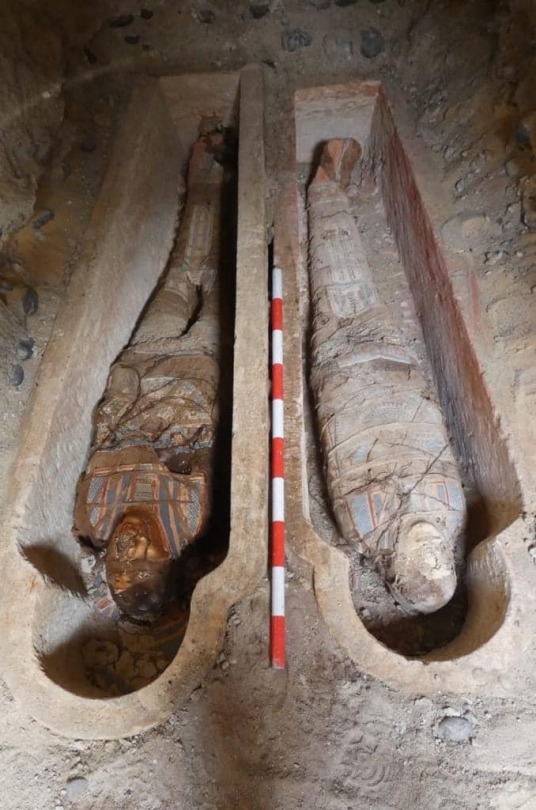
Archaeologists Unearth Mummies with Golden Tongues in Egypt
Archaeologists have unearthed several ancient tombs with dozens of mummies—including some with golden tongues.
Researchers made the findings during excavations at the ancient city of Oxyrhynchus, an extensive archaeological site located around 100 miles south-southwest of Cairo near the modern-day municipality of Al-Bahnasa in Minya Governorate.
Oxyrhynchus was "very important" during ancient Egypt's Greco-Roman period, which spanned hundreds of years from the late fourth century B.C. until the 7th century, Esther Pons Mellado and Maite Mascort, co-directors of a Spanish archaeological mission at the site.
"[It[ was the second city of Egypt after Alexandria. There was a great business and cultural relationship between these two cities," they said.
The Greco-Roman period began with Alexander the Great's conquest of Egypt—then controlled by the Persians—in 332 B.C. An ancient Greek state known as the Ptolemaic Kingdom was subsequently established in 305 B.C., which ruled Egypt until 30 B.C. when the region was conquered by the Romans.
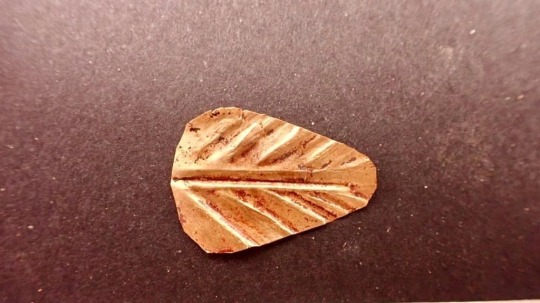
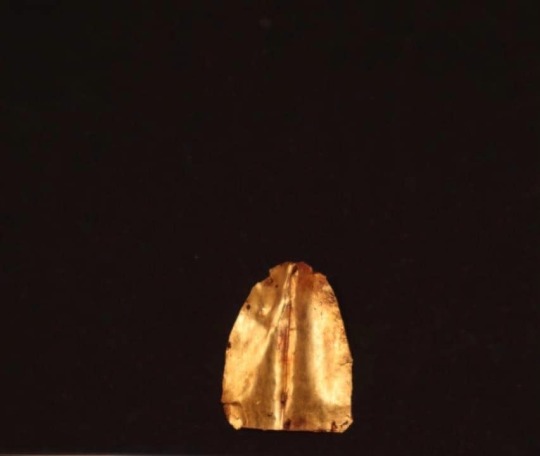
The territory became a province of the Roman Empire, which eventually divided into a western and eastern portion—with Egypt belonging to the latter. The Roman period ended around A.D. 641 when Arab forces conquered Egypt.
The latest excavations at Oxyrhynchus took place in November and December 2023. Over the course of these investigations, Pons Mellado, Mascort and colleagues discovered several tombs from the Greco-Roman era, as well as human remains and artifacts.
The finds include two tombs dating to the Roman period, built with limestone blocks. In these tombs, the archaeologists uncovered more than 20 mummified individuals covered in multi-colored wrappings, as well as papyri with Greek texts and mud seals with Egyptian iconography.
Two of these mummies were found to have pieces of gold shaped into the form of a human tongue placed where their real tongue was. Such golden tongues have previously been found at Oxyrhynchus and, indeed, other archaeological sites in Egypt.
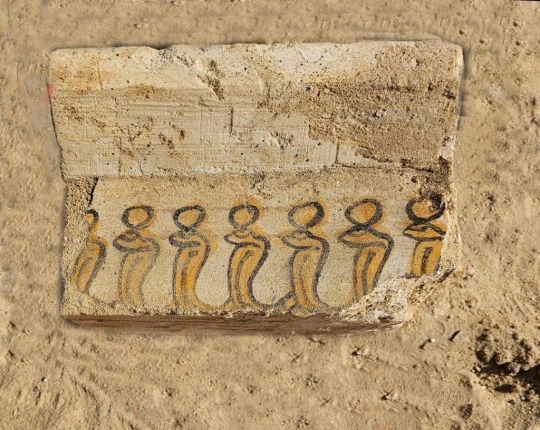
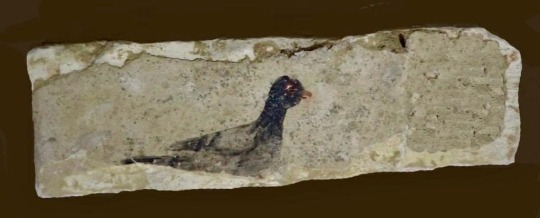
"Until now we have found 16 golden tongues in Oxyrhynchus," Pons Mellado and Mascort said.
Experts think the ancient Egyptians may have placed gold tongues on some human remains to enable the spirits of the deceased to communicate with Osiris—the god of the underworld—and to help them cross into the afterlife.
"The Egyptian people deposited the golden tongues on the tongue to restore vital functions to the dead and also so that the body remained intact in the afterlife. For the Egyptians, gold was the flesh of the gods," Pons Mellado and Mascort said.
In addition to the Roman-era tombs, the archaeologists also discovered three "hypogea"—or underground tombs—dating to the Ptolemaic period that had been excavated beneath the natural rock.
In these hypogea, the researchers uncovered several more mummies covered in colorful wrapping, a number of anthropomorphic stone sarcophagi (some of which were closed) and various terracotta statues depicting the goddess Isis-Aphrodite, among other artifacts. This deity is a form of the Egyptian goddess Isis combined with the fertility aspects associated with the Greco-Roman goddess Aphrodite.
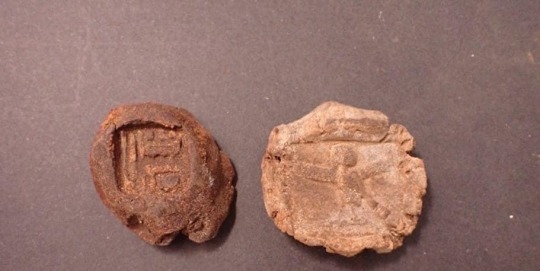

In one of the hypogea, the team also found many multi-colored limestone blocks with decorations, including depictions of humans, snakes, pigeons and plants.
All these findings are very important for the history of the funerary world in Oxyrhynchus," Pons Mellado and Mascort said.
"It is the first time that we have found an Oxyrhynchus terracotta with the image of Isis-Aphrodite, and the first time that this kind of piece has appeared in this area of Middle Egypt. The limestone blocks with decoration [are also very important]."
The limestone blocks—another new finding at Oxyrhynchus—appear to have come from some kind of construction, although the nature of the structure is unclear.
By Aristos Georgiou.
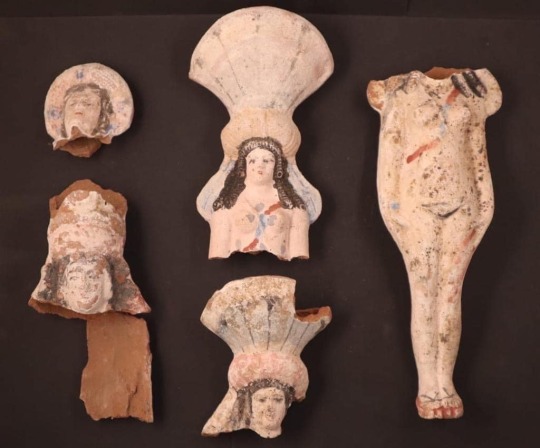

#Archaeologists Unearth Mummies with Golden Tongues in Egypt#ancient city of Oxyrhynchus#Greco-Roman period#ancient graves#ancient tombs#ancient artifacts#archeology#archeolgst#history#history news#ancient history#ancient culture#ancient civilizations#ancient egypt#egyptian history#roman history
83 notes
·
View notes
Text
Why have we as a society decided that it is perfectly alright to find and dig up the dead bodies of Ancient Egyptians, simply because its interesting.
Now I think that Ancient Egypt is interesting, infact, I have previously taken interest in the Ancient Egyptians beliefs, why they were buried the way they were, how they lived ect.
HOWEVER
I recently went to a museum as they had an Ancient Egypt exhibit, I enjoyed my experience but walked away with a dilemma. My dilemma had begun from about half way through exhibit, 2 entire rooms of the exhibit, filled with empty outter coffins, empty inner coffins and mummified human remains.
Why does anyone think it is alright to dig up dead bodies, take them from their tombs and leave their wrapped up dead bodies on display for anyone to see.
These were people, walking, talking, breathing human beings. They worked, the loved, they ate, they drank, hell they even wore makeup.
I don't think that many people would want their dead body to be placed in a museum after being dug up in an excavation.
These people have been separated from the things left in their coffins, such as prayers and heart scarabs, to protect them in the after life, their organs separated from them. Their bodies having been scanned to see what is beneath the wrappings.
One such mummy that I saw, was that of a girl, a mere 16 year old girl, who passed from disease. I stood there for a second, staring at the wrappings of her body through the glass, an unnamed, unknown girl. I tried to imagine how she would feel finding out that her body was on display, that anyone could see the her wrappings, her body not far beneath.
On the opposite side of the room, on a stand under glass was a scarab, taken from beneath wrappings, taken from the body of a person who likely believed that it could protect them in the afterlife.
On top of all of this. Many people around me were taking photos of the mummies. There is only one arguement that I have heard to "justify" taking pictures.
"Well history needs to be remembered"
History can be remembered without having to take apart someones grave, History can be remembered without having to put someones body on display, History can be remembered and taught about without disrespecting dead people.
I wish to hear what others think about about this topic.
SO
I will attach some pictures I took, no images of mummifued remains will be shown as I did not take any. However grainy filters have been added as my reflection is in many of them and I prefer to not expose my real face online.
The pictures consist of:
Organ Jars
A portrait of a man
Inner coffins (the smaller ones)
Outter coffins (the bigger ones)
A Heart scarab
A page from the book of the dead
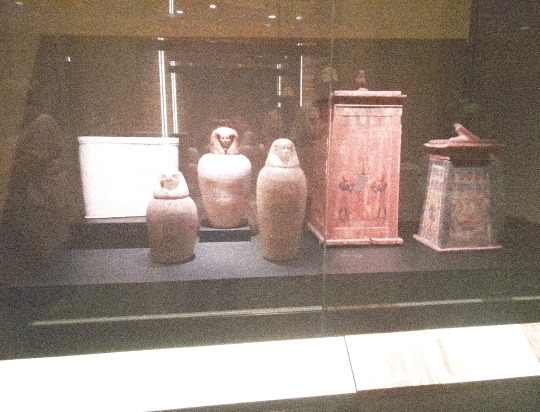
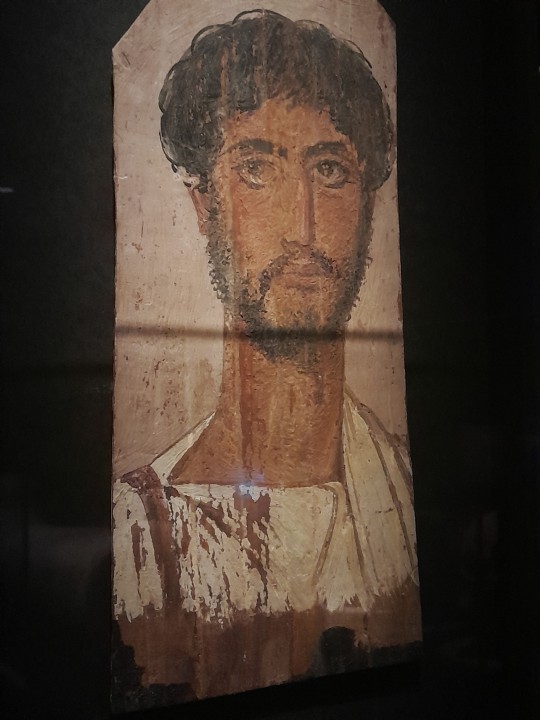
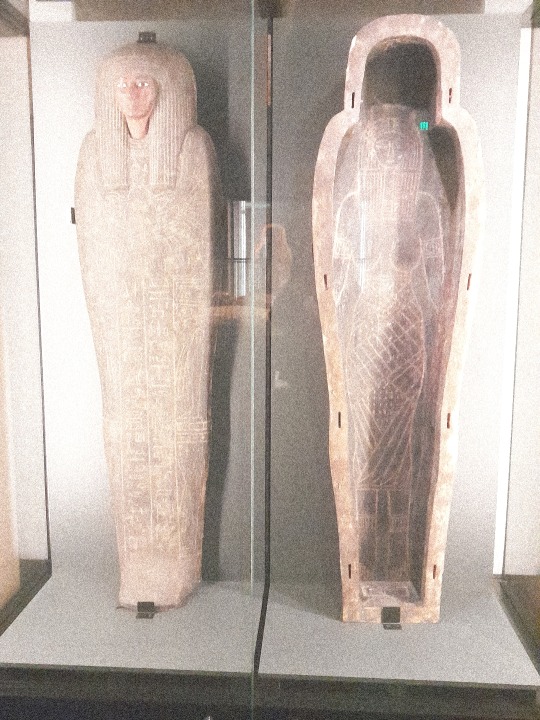
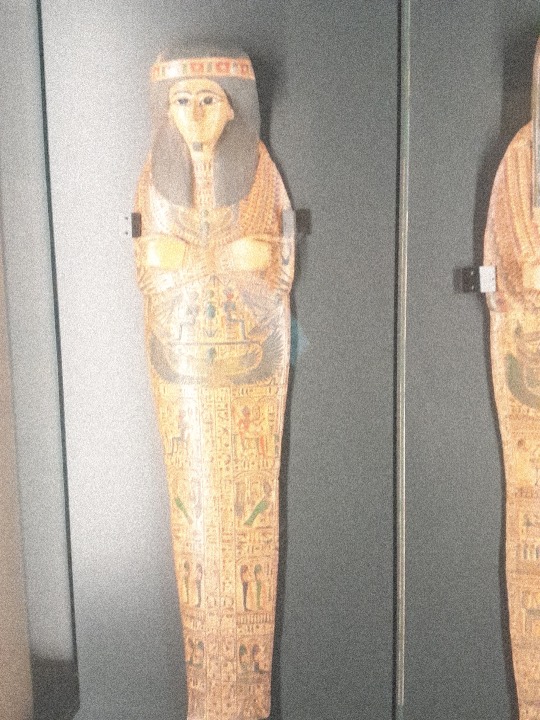
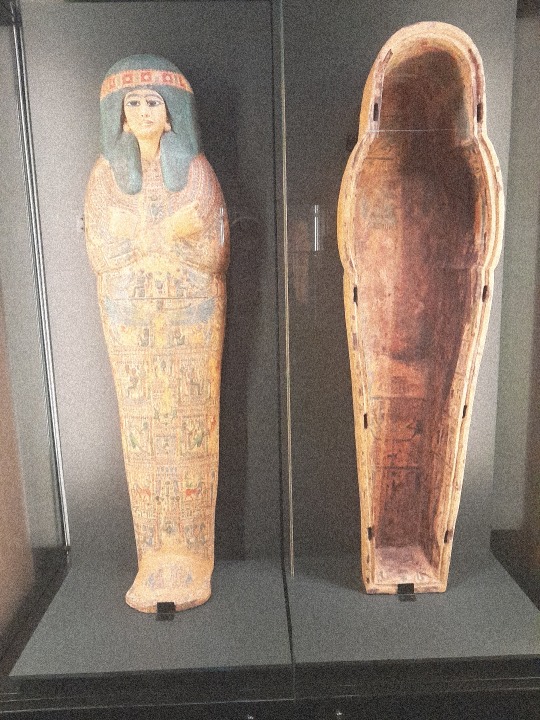

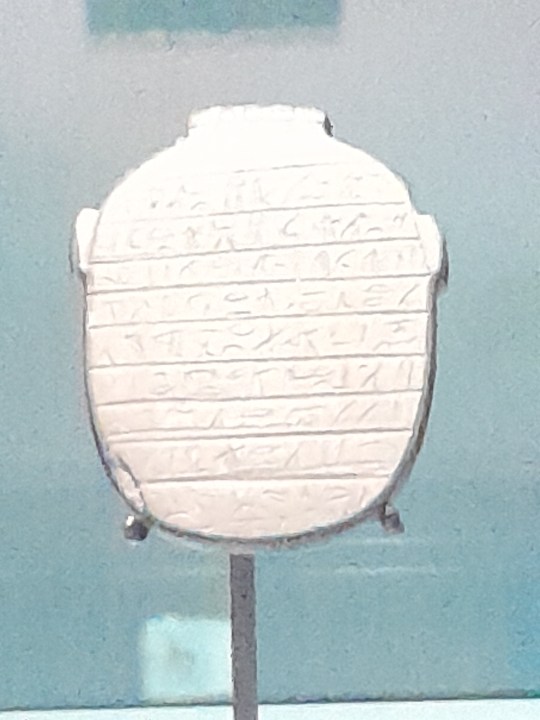
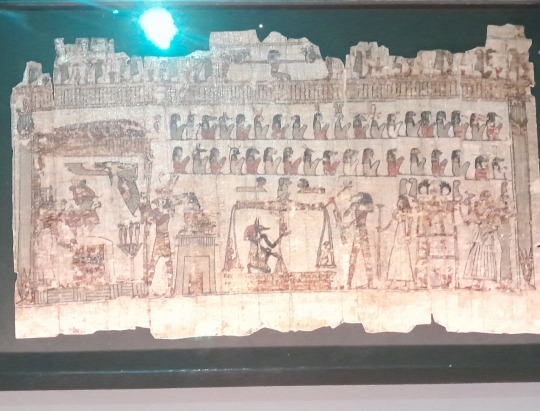
#ancient history#ancient egypt#history#opinion#i dont know how to tag stuff#historical#historic#mummies#mummification#ancient egyptian mummies#i dont like how this is delt with#be nice to me#again opinion#this is my first longer opinion post#important#morals#graves
98 notes
·
View notes
Text

CHINCHORRO
The Chinchorro mummies are mummified remains of individuals from the South American Chinchorro culture, found in what is now northern Chile. They are the oldest examples of artificially mummified human remains, having been buried up to two thousand years before the Egyptian mummies.
[wiki]
9 notes
·
View notes
Text
The Strange Journey of John Lennon’s Stolen Patek Philippe Watch
For decades, Yoko Ono thought that the birthday gift was in her Dakota apartment. But it had been removed and sold—and now awaits a court ruling in Geneva.
By Jay Fielden June 17, 2024

The missing watch, now valued at between ten and forty million dollars, was a fortieth-birthday gift from Yoko Ono, along with a tie she knit herself.Photograph by Bob Gruen
For years, John Lennon’s Patek Philippe 2499 has been the El Dorado of lost watches. Lennon was known for collecting expensive things: apartments in the Dakota (five); guitars (one apartment was mainly for musical equipment); country estates; jukeboxes (three); and Egyptian artifacts, including a gold-leafed sarcophagus containing a mummified princess, who Yoko Ono believed was a former self. But the Patek appears to have been his one and only wristwatch.
A gift from Ono, the watch is more than anyone would ever need to tell the time. A perpetual-calendar chronograph, it is, as Paul Boutros, the head of watches at the American arm of Phillips auction house, says, a “mechanical microcomputer, the most sought after of all Pateks.” Between 1952 and around 1985, Patek produced just three hundred and forty-nine of them. The watch, which Ono bought at Tiffany on Fifth Avenue, records time in eight different ways; the dial houses three apertures (day, month, moon phase) and three subdials (seconds, elapsed minutes, date). If you never memorized the mnemonic “thirty days hath September,” no worries—the 2499 Patek hath. Its miraculous ganglia of tiny wheels and levers will adjust its readings to the quirky imperfections of the Gregorian calendar, including leap years. No other watchmaker was able to produce a perpetual-calendar-chronograph movement small enough to fit into a wristwatch until 1985.
What makes this 2499 even rarer—and perhaps the most valuable wristwatch in existence—is how little we know about it. Ono gave it to her husband for his fortieth birthday, on October 9, 1980, two months before he was fatally shot by a deranged man outside the Dakota. For the next three decades, the existence of the watch remained unknown except to a handful of family and close friends.
But, sometime around 2007, in the early days of social media, a new kind of watch obsessive materialized, equipped with native computer skills and an appreciation for the places where pop culture and the luxury market intersect. In those pre-Instagram years, fanboy wonks traded watch esoterica online: an image of Picasso wearing a lost Jaeger-LeCoultre; Castro with two trendy Rolexes strapped to one arm; Brando, on the set of “Apocalypse Now,” “flexing,” as watch geeks say, a Rolex GMT-Master without its timing bezel, a modification he made to better inhabit the role of Kurtz; and—the Google image-search find of them all—two frames of an uncredited snapshot of Lennon and his Patek.

“I’m not a watch guy,” Sean Lennon said. “I’d be terrified to wear anything of my dad’s. I never even played one of his guitars.”Photograph by Bob Gruen
Since its discovery, around 2011, the image has appeared online again and again, fuelling a speculative frenzy about what the watch—which cost around twenty-five thousand dollars at Tiffany in 1980—might bring at auction today, with estimates ranging from ten million to forty million dollars. (Bloomberg’s Subdial Watch Index tracks the value of a bundle of watches produced by Rolex, Patek, and Audemars Piguet, like an E.T.F.; the Boston Consulting Group reported that, between 2018 and 2023, a similar selection outperformed the S. & P. 500 by twelve per cent. In 2017, Paul Newman’s Rolex Daytona broke records by selling at auction for $17.8 million.) But all the clickbait posts about the Lennon Patek, as it had come to be known, were regurgitations that contained few facts. There was never a mention of who took the photo, where it was taken, or even where the watch might be.
During the long, dull days of the pandemic, I decided to see what I could find out. Several years went by, as I traced the journey of the watch from where it was stowed after Lennon’s death—a locked room in his Dakota apartment—to when it was stolen, apparently in 2005. From there, it moved around Europe and the watch departments of two auction houses, before becoming the subject of an ongoing lawsuit, in Switzerland, to determine whether the watch’s rightful owner is Ono or an unnamed man a Swiss court judgment refers to as Mr. A, who claims to have bought the watch legally in 2014.
Having reached its final appeal—Ono has so far prevailed—the case is now in the hands of the Tribunal Fédéral, Switzerland’s Supreme Court, which is expected to render a verdict later this year. Meanwhile, the watch continues to sit in an undisclosed location in Geneva, a city that specializes in the safe, secret storage of lost treasures.
Lennon holding up his birthday Patek in the fall of 1980 is one of the happiest moments captured on film in the final years of his life. That summer, he’d begun making music again, during a trip to Bermuda which he’d hoped would help repair the well-publicized strain in his marriage to Ono. Lennon’s “lost weekend”—more than a year spent living in Los Angeles with May Pang, a former assistant who became his lover—was not that far in the past, and Ono had fallen into an infatuation with an art-world socialite named Sam Green. (It was in Bermuda that Lennon wrote “I’m Losing You.”)
Lennon had spent the previous five years holed up in the Dakota as a self-proclaimed “househusband,” raising his son Sean so that Ono, whom Lennon called Mother, could take her turn at being the decision-maker of the music-business enterprise they’d named Lennono. While Ono dealt with Beatles headaches, controlled the purse strings, and invested in real estate, Lennon occupied himself by watching soap operas, eating bran biscuits and rice, smoking Gitanes, and listening to either classical music or Muzak. “If I heard anything bad,” he later explained, “I’d want to fix it, and if I heard anything good, I’d wonder why I hadn’t thought of it.”
In the photograph, Lennon, trim and fit from a macrobiotic diet, wears jeans and a loosely knotted striped knit tie adorned with a jewel-encrusted American-flag pin. The picture was taken in the Hit Factory, where he and Ono had been recording “Double Fantasy,” his first album in five years. The room is dim, but he has on sunglasses, celluloid horn-rims recently bought in Japan. Buckled on his left wrist is the Patek 2499.
In order to find out more about the photograph, I tracked down Jack Douglas, the noted record producer who oversaw “Double Fantasy,” and sent him the picture by e-mail. He replied right away. “Bob Gruen took the photo,” he wrote, referring to the well-known documenter of the seventies and eighties rock scene.
When I contacted Gruen, who is now seventy-eight and lives in New York City, he had no idea that his photograph had become the talk of the horological world or why he’d never been given credit for it; he’d published the image in a book, titled “John Lennon: The New York Years,” in 2005. But he remembered the night he took the photo—Lennon’s fortieth birthday. Since late that summer, Lennon and Ono had been spending a lot of time in a multiroom studio on the sixth floor of the Hit Factory building, then on West Forty-eighth Street. “I was one of the few people who had an open invitation,” Gruen told me. “They liked to work late.” Gruen, who said he was living on a “steak-and-Cognac diet” in those days, showed up after midnight, having attended the thirty-sixth-birthday party of the singer Nona Hendryx. “I thought I’d bring John a piece of her birthday cake,” he said.
When Gruen arrived, Lennon was enjoying his presents: the knit tie, which Ono had made herself (a copy of the one he wore at school in Liverpool); the flag pin; and the Patek, in yellow gold, which had a rare and highly coveted double-stamped dial, meaning that both the watchmaker’s and Tiffany’s logos were printed on it. Gruen remembered Lennon being abuzz over the tie and the pin, a nod to Lennon’s fourth anniversary as a green-card holder. He doesn’t recall talking about the watch. But Lennon nonetheless strapped the black lizard band onto his wrist when Gruen reached for his Olympus OM4.
A few other photographs that Gruen took that week have never been seen by the public. One shows Lennon at a mixing board with Douglas, who is wearing a recognizable watch himself, a Porsche Design Chronograph I—stainless steel and coated in black—which Porsche had presented to him and to the members of Aerosmith in 1976, after the band’s German tour for its album “Rocks.” Douglas told me that he and Lennon later wrist-checked each other. “Although I thought his watch was beautiful,” he wrote in an e-mail to me, “I told John it didn’t have the pizzazz of my black beauty, and we had a good laugh.
After Lennon’s death, Ono had a full inventory taken of her husband’s possessions, a document that amounted to nearly a thousand pages. She then put the Patek in a locked room of her apartment. And there the watch remained for more than twenty years.
I found a clue as to what happened next by putting together shards of information from various members of the watch intelligentsia who had all “heard” that the Patek had been stolen. “I think the guy was Turkish,” one said. Another remembered “something about a chauffeur.” This led me to a 2006 article in the Times about a man named Koral Karsan (Turkish: check), who had served as Ono’s chauffeur (check two) for the previous ten years. Karsan, a veteran member of Ono’s oft-shuffled staff—trusted enough that he had full access to her apartment—had simply gone berserk in December of that year, threatening to release embarrassing photos and private conversations he’d been recording unless Ono paid him two million dollars; he allegedly said that if she refused he would have her and Sean killed.
A tall, square-jawed man with a thick burr of white hair, Karsan, then fifty, was arrested. In a series of preliminary hearings in a Manhattan courtroom, he defended himself against charges of extortion and attempted grand larceny by claiming, as the Times reported, that Ono had “humiliated and degraded him, wrecking his marriage and making him so nervous that he ground eight of his teeth to the bone.” A letter he’d written to Ono describing himself as her “driver, bodyguard, assistant, butler, nurse, handyman and more so your lover and confidant” was also entered into the record. Ono disputed Karsan’s claims about a romance, but the prosecution allowed him to plead guilty to a lesser charge, and he was ordered to return to his native Turkey.
According to a story that Karsan would later tell, Ono—who was known to consult psychics—became worried one day in 2006 that a forecasted heavy-weather event might endanger some meaningful Lennon items, including two pairs of Lennon’s eyeglasses and several New Yorker desk diaries (which he used as journals during the last five years of his life); she asked Karsan to find a safer place to keep them. Unbeknownst to Ono, when Karsan was subsequently deported, these items, along with the Patek, followed him.
Ono, who is ninety-one and lives in seclusion in upstate New York, declined to comment. Of Karsan, Sean Lennon told me, “He took advantage of a widow at a vulnerable time. Of all the incidents of people stealing things from my parents, this one is the most painful.”
Karsan, back in Turkey, was in the market for a house. Around 2009, he showed Lennon’s watch to a Turkish friend visiting from Berlin named Erhan G (as he came to be known owing to German privacy laws). Karsan let Erhan G flip through the diaries, including one marked 1980, which includes Lennon’s final entry. Karsan threw out an idea: he’d give the Lennon Patek to Erhan G as collateral for a loan. Erhan G agreed.
One evening in 2013, in Berlin, Erhan G met an executive who worked for a new, much hyped digital auction platform called Auctionata. He couldn’t resist boasting about the Patek 2499 and the rest of the Lennon trove—some eighty items. In short order, a dinner was arranged with Oliver Hoffmann, Auctionata’s twenty-eight-year-old director of watches. “He told me the story of how he’d gotten the watch,” Hoffmann recalled, of his meeting with Erhan G. “It was strange, but it felt whole and true. It was credible because of the many details.” Erhan G, who said that he was the watch’s rightful owner, per an agreement with Karsan, didn’t strike Hoffmann as a man desperate for money. “He owned a successful business and lived in a large apartment in a building close to Potsdamer Platz,” Hoffman said. (Erhan G could not be reached for comment.)
Auctionata, which live-streamed its auctions, was one of Germany’s dot-com darlings, lauded in the press for disrupting the old auction-house model, dominated by Christie’s and Sotheby’s, which had yet to develop a digital-first business. Investors including Groupe Arnault, Holtzbrinck Ventures, and Hearst Ventures had put up more than a hundred million dollars of venture capital for the company. Hoffmann says that the C.E.O., Alexander Zacke, recognized what a publicity boon selling John Lennon’s lost watch would be and pushed for a way to do it with or without notifying Ono. (Zacke did not respond to a request for comment.) Teams of lawyers studied the watch’s provenance and puzzled over how to offer it for sale without raising eyebrows. A document called an extract was obtained from Patek Philippe, which meant that the watch had not been registered as stolen, and Karsan himself travelled to Berlin, where he signed a document in front of a notary testifying that Ono had given him her husband’s Patek as a gift in 2005. As for the authenticity of the watch, there was no doubt: on the case back is an identifying inscription that has never been made public outside Germany.
In late 2013, in preparation for an auction, Auctionata had the watch professionally photographed. (In the photo, the watch floats in a vacuum, a carefully lit token of commerce, divorced from all human and emotional context.) But Erhan G got cold feet. Some years earlier, Ono had sued a former employee who had slipped out of the Dakota with Lennon memorabilia; Frederic Seaman, Lennon’s last personal assistant, confessed to having stolen diaries similar, if not identical, to those which Karsan and Erhan G had stashed away. (He later returned them.) Searching for a private buyer, Hoffmann approached Mr. A, a man he knew from the rare-watch circuit. A deal by “private treaty”—a sale undisclosed to the public—was reached, and in March, 2014, Mr. A agreed that he would consign a selection of Rolex and Patek watches from his own collection, whose sale proceeds would go toward payment for the Lennon 2499, which was priced at six hundred thousand euros (about eight hundred thousand dollars). “This, in some ways, was more helpful than auctioning the watch,” Hoffmann told me, explaining that Auctionata’s watch department needed the inventory. The vintage watches Mr. A consigned, most of which Hoffmann valued at between twenty thousand and forty thousand euros apiece, were in total likely worth more than the 2499.
Mr. A told Hoffmann that he planned to keep Lennon’s watch in his collection, which has included pieces owned by Eric Clapton. But, within months, he took the Lennon Patek to the Geneva office of Christie’s. As part of the auction house’s appraisal process, a Christie’s representative reached out to Ono’s lawyer, who promptly notified his client. Ono rushed to check the locked room, only to discover that the Patek wasn’t there. She had no idea how long it had been gone.
In August of 2023, a reporter named Coline Emmel, who works for a small but enterprising Web site in Switzerland called Gotham City, found something interesting in a backlog of documents filed that summer by the Chambre Civile in the canton of Geneva—an appellate judgment in a civil case that had been going on for five years. European privacy laws, especially those in Switzerland, make legal documents unusually hard to decipher. The Swiss judiciary uses a system of letters and numbers to create pseudonyms for appellants, respondents, and anyone else involved, turning a case file into a cryptogram. Emmel knew enough about Beatles history to recognize that “C_____, widow of late F_____, of Japanese nationality and domiciled in [New York City]” was, in fact, Yoko Ono. Although the appeals court affirmed the lower court’s decision that Ono was the “sole legitimate owner of the watch,” Mr. A—“a watch collector and longtime professional in the sector, of Italian nationality”—was launching another appeal. Emmel posted a brief synopsis on Gotham City, along with the news that a final judgment was now being awaited from the Swiss Supreme Court.
“Mystery solved!” was the gist of the message that ricocheted around the watch world. But, to me, the mystery had only deepened. The basic itinerary of the Patek’s odyssey and its current location had been discovered, but the human detail of how it had passed from wrist to wrist, hiding place to hiding place, still hadn’t been reported. What’s more, where had Ono ever got the idea of giving a guy like John Lennon—eater of carob-coated peanuts, singer of a song about imagining no possessions, peacenik—a watch that was a status symbol of lockjawed good taste? And what was its famously secret inscription?
I had already been in contact with Mr. A; three days before Emmel posted her scoop, he’d cancelled a planned meeting with me in Italy. Instead, we arranged to speak over Zoom. Seated in a panelled room, he told me that, when Ono had found the watch missing, her counsel demanded its return. It was a tricky legal situation, because Ono, having never realized that the watch was gone, hadn’t reported it stolen, and because the case spans several national jurisdictions. Mr. A explained that he didn’t return the watch because he didn’t believe it to be stolen property. He mentioned the inventory that had been taken of Lennon’s possessions after his death, which was referred to in the judgment; he claimed that only two watches were listed—a gold watch (presumably the Patek) and another that Mr. A said was a pocket watch Ono had auctioned through Sotheby’s in 1984, two decades before Karsan swore she gave him the Patek.
Mr. A pointed to Ono’s own version of the story. “Following the death of the late [John Lennon],” the Swiss court’s judgment reads, in a summary of a deposition that Ono gave to investigators from Berlin at the German consulate in New York City, “[Ono] wanted to give something belonging to her to those who had worked very faithfully for her. So, she told [Karsan] to take a watch.” Ono, however, added that she in no way meant the “watch she’d given the late [John Lennon].” What watch did she mean? Mr. A asked rhetorically. “There was only the Patek.”
Christie’s, informed that the watch had been stolen, kept the 2499 secured in its Geneva vault, where it sat for several years. The judgment states, “On December 17, 2015, the parties and [Christie’s] SA entered into a consignment-escrow agreement under which the Watch would be consigned to [Mr. A’s lawyer], until agreement or right is adjudicated on the property.” (Christie’s did not respond to a request for comment.) Mr. A told me that he eventually decided to go on the offensive. In 2018, he initiated a civil lawsuit against Ono to prove that he was the Patek’s rightful owner.
What Mr. A never expected was that his fate would become intertwined with that of Auctionata, which went bankrupt in early 2017. A German court brought in a bankruptcy expert and lawyer named Christian Graf Brockdorff, who, in a review of the company’s inventory, stumbled on the eighty-odd other Lennon items that Erhan G had consigned for a high-six-figure sum. “I doubted that everything that had happened in the past was legally correct,” Brockdorff told me in an e-mail. He contacted the police; a criminal case was opened, and Erhan G was found guilty of knowingly dealing in stolen goods. He served a one-year suspended sentence, having admitted that the story that Karsan had told of how he got the Lennon items “did not correspond to reality.” (A Europol warrant was issued for Karsan, whose whereabouts are unknown; he could not be reached for comment.) That the case itself ever came to be is curious, but its verdict set a legal foundation that the Swiss judgment cited in declaring that Mr. A is not the watch’s rightful owner. According to Guido Urbach, a knowledgeable Swiss attorney, it is unlikely that the Supreme Court will decide any differently.

The secret dedication that Ono had inscribed on the back of the Patek Philippe 2499: “(JUST LIKE) / STARTING OVER / LOVE YOKO / 10 • 9 • 1980 / N. Y. C.”
In a series of follow-up e-mails, I asked Mr. A about what John Lennon’s Patek meant to him. “I’m more of a Rolling Stones man,” he replied, mentioning that he has played bass in a local band for years. Still, “to own the JL watch is really a double good feeling,” he said, adding that he remained hopeful that he could “wear it as soon as possible.”
But, if the Supreme Court confirms the appellate court’s ruling, the watch will likely return to New York. “It’s important that we get it back because of all we’ve gone through over it,” Sean Lennon told me. He added, “I’m not a watch guy. I’d be terrified to wear anything of my dad’s. I never even played one of his guitars.” He paused. “To me, if anything, the watch is just a symbol of how dangerous it is to trust.”
The watch never seems to have given anyone peace and happiness for long. When Lennon was in Bermuda, writing what he described as the best kind of songs—“the ones that come to you in the middle of the night”—Ono was spending time with Sam Green, whom the Times once described as “an unabashed poseur blessed with good looks.” Green had a way with rich and eccentric women. He’d had an affair with the Bakelite heiress, Barbara Baekeland, and by 1980 he was spending his time juggling Greta Garbo, Diana Vreeland, and Ono.
Looking through Green’s papers, which are at Yale’s Beinecke Library, I got an eerie feeling. I found a number of diary entries that corroborated his close relationship with Ono (“Yoko all day and night,” numerous notations read), and a handwritten tally for more than twenty-five thousand dollars—the cost of furniture that Green had sourced to appoint the Hit Factory studio. Whether Green was the one who suggested the Patek as a birthday present for Lennon is hard to confirm, but the cursed history of the watch invites speculation.
The secret engraving, which I found in the never-published Auctionata photo of the watch, is haunting in another way:
Was there a new start? By the time “Double Fantasy” was finished, Ono had lost interest in Green, and Lennon, who had just written and recorded no fewer than four love songs about her, appeared to be a happy man. The weeks they spent together at the Hit Factory that year had been charmed, which means that the Lennon Patek captures a measure of time that no other watch ever will—the little they had left together. ♦
Published in the print edition of the June 24, 2024, issue, with the headline “In Search of Lost Time.”
7 notes
·
View notes
Text
people are so casual about displaying egyptian mummies, like those are human remains. I was at a fuckin. geology museum. and there was a mummified lizard fossil. very cool. but they were like "as a point of comparison in case you have no fuckin idea of what a mummy is, here is a big photograph of a dead body in our fuckin rock cabinet"
7 notes
·
View notes